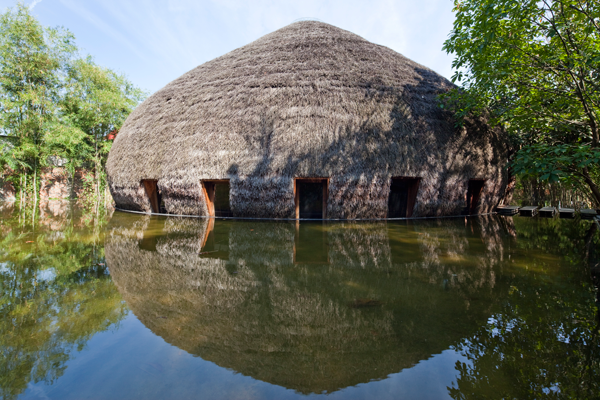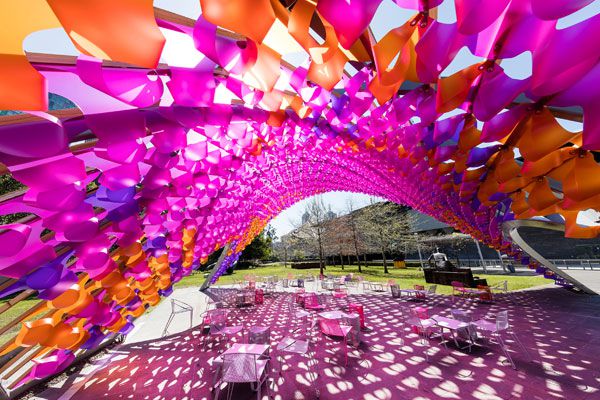A remarkable, organic structure composed entirely of bamboo at the centre of an artificial lake, the wNw Bar (Wind and Water Bar) creates a warm, inviting environment that rhymes with the lush surrounding nature.

September 3rd, 2014
Rising from a lake situated amongst dense bamboo forests, Wind and Water bar is deceptively simple when seen from the exterior. The approach traverses rectangular stepping stones and leads you a visitor across the large elevated lake and into the structure, which is used as a venue for cultural activities such as music performances and shows, as well as social activities like local meetings.
To support the structure’s tall dome, Vo Trong Nghia Architects designed a bamboo arch system 10m high and spanning 15m across. The main frame is made up of 48 prefabricated units, each of which were assembled from various lengths of bamboo, then bound together and bent into arches.
Whilst local craftsmanship was crucial in the project’s realisation, the aim of the design was not merely to support folk handicrafts in local areas but to create a green building that fuses tradition with modern design. Therefore it was essential to develop an efficient system of production and construction for the bamboo components. Thus the whole structure was divided into several frame-units, which were more cost-effective and reduced inaccuracies. The on-site assembling of these frame-units also brought more flexibility in transporting the bamboo structure.
The building uses natural wind energy together with the cool water from the lake to create ventilation. A circular skylight with a diameter of 1.5m allows hot air to escape and thus draws cool air in from the base of the building. These passive design methods reduce the energy consumption of the building greatly.
Projects such as this pair low-cost investment and rapid assembly (wNw Bar was built by local workers over a three month period), and promise them employment without environmental degradation.
Architect Firm: Vo Trong Nghia Architects
Principal architect: Vo Trong Nghia
Location: Binhduong, Vietnam
GFA: 270m2
Site Area: 1160m2
Photographs: Hiroyuki Oki, Vo Trong Nghia Architects
INDESIGN is on instagram
Follow @indesignlive
A searchable and comprehensive guide for specifying leading products and their suppliers
Keep up to date with the latest and greatest from our industry BFF's!

The Sub-Zero and Wolf Kitchen Design Contest is officially open. And the long-running competition offers Australian architects, designers and builders the chance to gain global recognition for the most technically resolved, performance-led kitchen projects.

Schneider Electric’s new range are making bulky outlets a thing of the past with the new UNICA X collection.

How can design empower the individual in a workplace transforming from a place to an activity? Here, Design Director Joel Sampson reveals how prioritising human needs – including agency, privacy, pause and connection – and leveraging responsive spatial solutions like the Herman Miller Bay Work Pod is key to crafting engaging and radically inclusive hybrid environments.

Registrations for the National Gallery of Victoria’s 2016 Architecture Commission Design Competition are open.

The adaptive reuse of Paris’ former commodities exchange into a contemporary art museum, the Bourse de Commerce – Pinault Collection by Tadao Ando, is something else.
The internet never sleeps! Here's the stuff you might have missed

Nicole Larkin has been awarded the 2025 Marten Bequest, providing two years and $50k to research coastal resilience and adaptation.

The Australian Institute of Landscape Architects (AILA) NSW Chapter has announced the winners of the 2025 NSW Landscape Architecture Awards.